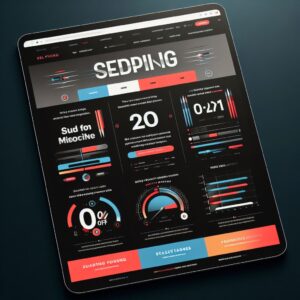Have you ever found yourself browsing a website on your mobile phone and had to constantly zoom in or scroll sideways to view the content? This frustrating experience is becoming less and less common thanks to responsive web design. A responsive web design is one that automatically adapts to the size and orientation of any device, from a desktop screen to a small smartphone screen. In this article, we will explore in depth what responsive web design is, why it is so important, and how you can implement it on your own website.
What is responsive web design?
Responsive web design is a technique that allows a website to adjust to any screen size smoothly and without losing its functionality or aesthetics. Imagine a chameleon that changes color to adapt to its environment: a responsive website does the same, adapting to the different screen resolutions of users’ devices.
Why is responsive web design important?
- Better user experience: Users expect to be able to access information easily and quickly, regardless of the device they are using. A responsive design ensures a smooth and enjoyable browsing experience.
- Increased visibility in search engines: Google and other search engines prioritize responsive websites in their search results. This means that a responsive website is more likely to appear in the top positions of search results.
- Increased conversions: A responsive design can increase conversions, as users will find it easier to make purchases, fill out forms, or contact you.
- Reduced maintenance costs: By having a single website that adapts to all devices, you will reduce maintenance and development costs.
The basic principles of responsive web design
- Fluid design: Design elements adjust proportionally to the size of the screen.
- Responsive images and videos: Images and videos scale automatically to fit different screen sizes.
- Flexible grids: Grids allow content to be organized in a structured and adaptable way.
- Media Queries: Media queries are CSS rules that allow you to apply different styles depending on the screen size.
How to implement a responsive web design
- Use a CSS framework: CSS frameworks like Bootstrap or Foundation provide a predefined structure and pre-designed components that speed up the development process.
- Optimize your images: Compress your images without losing quality to speed up your website’s loading time.
- Test your website on different devices: Use emulation tools and real devices to ensure your website looks and works correctly on all devices.
- Monitor performance: Use analytics tools to track your website’s performance and make adjustments if necessary.
Examples of responsive web design in real life
- Online stores: Large online stores like Amazon and Zara are excellent examples of responsive web design. Their websites adapt perfectly to any device, making online shopping easy.
- Designer portfolios: Designers often have very visual websites with animations and interactive effects. Seeing how they adapt their designs to different screen sizes can be very instructive.
- Blogs and online magazines: Blogs and online magazines have also adapted to responsive design to offer a better reading experience on mobile devices.
Additional benefits of responsive web design
- Greater accessibility: A responsive web design makes your website more accessible to people with disabilities.
- Better SEO: Google rewards responsive websites, which can improve your search engine ranking.
- Greater customer satisfaction: A responsive website shows that you care about your users’ experience.
Responsive Web Design and SEO
One of the biggest advantages of responsive web design is its positive impact on SEO. Google has made it clear that it prioritizes websites that offer a good user experience on all devices. By having a responsive website, you are sending a clear signal to search engines that you care about your users and are offering them the best possible experience.
- Content indexing: Search engines can index and display your content more effectively in search results.
- Loading speed: An optimized responsive website loads faster, which improves user experience and is also an important ranking factor for Google.
- Signal of authority: Google considers responsive websites to be more relevant and authoritative.
Tools for Creating Responsive Web Designs
There are numerous tools and frameworks that can help you create responsive web designs quickly and efficiently. Some of the most popular include:
- CSS frameworks: Bootstrap and Foundation are two of the most widely used CSS frameworks. They provide a predefined structure and pre-designed components that speed up the development process.
- CSS preprocessors: Sass and Less allow you to write CSS more efficiently and modularly, which is especially useful for large and complex projects.
- Code editors: Visual Studio Code, Sublime Text, and Atom are powerful code editors that offer features such as auto-complete, syntax highlighting, and extensions for web development.
- Design tools: Figma, Sketch, and Adobe XD are design tools that allow you to create interactive prototypes and export CSS code.
The Most Common Challenges in Responsive Web Design and How to Overcome Them
Despite its many benefits, responsive web design also presents some challenges:
- Complexity: Creating a responsive web design can be more complex than a traditional web design.
- Development time: Developing a responsive website can take longer.
- Testing: It is essential to test your website on different devices and browsers to ensure that it works correctly.
To overcome these challenges, we recommend:
- Planning: Define a clear structure for your website before you start designing.
- Prioritization: Focus on the most important elements of your website and ensure that they adapt correctly to different screen sizes.
- Continuous testing: Test your website regularly on different devices and browsers.
- Use of tools: Use development and emulation tools to streamline the testing process.
The Future of Responsive Web Design
Responsive web design will continue to evolve as devices and technologies change. Some of the trends we will see in the future include:
- Progressive web design: An evolution of responsive web design that focuses on providing an optimal user experience on any device, even those with slow internet connections.
- Virtual and augmented reality: Responsive web design will need to adapt to new virtual and augmented reality technologies.
- Artificial intelligence: Artificial intelligence will be used to personalize the user experience based on their preferences and behavior.
Conclusion
Responsive web design is an essential practice for any website that wants to reach a global audience. By adapting your website to any device, you will improve the user experience, increase your conversions, and improve your search engine ranking.


